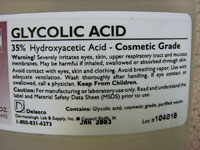
Glycolic acid belongs to the group of α-hydroxy acid (AHA). It is derived mainly from sugar cane, but also from fruits such as pineapple and unripe grapes. Citric acid from oranges and other citrus fruits also fall under the same classification as glycolic acid.
Glycolic acid is generally used as a natural skin exfoliant and moisturizer to improve the skin's appearance and texture. It can reduce wrinkles, acne scarring and hyper-pigmentation. On the superficial level, it works as an exfoliating agent by weakening the binding links holding the dead skin cells together in the upper layer of the epidermis,. As a result it removes excessive unhealthy dead skin together with the pigments, revealing the underlying skin with a smoother surface, more even skin tone and glow. It also helps to draw moisture into the newly exfoliated skin surface.
In the deeper level, it has some anti-oxidant properties to fight the free radicals, thereby reducing the damages. It also has a stimulating effect in the making of more collagen and elastin, so increasing the thickness and firmness of the dermis.
In the home setting, it is usually used as a cleanser or lotion in concentrations of 10% or lower. Dermatologists use it in much higher concentrations of 20% - 80% to induce a deeper peeling in more severe case of aged skin or acne scarring.
The side effects of using glycolic acid include stinging feeling, transient redness and dryness ( if not followed by a moisturize ). Too high concentration or over sensitive skin may result in excessive burning with a long period of redness, or even result in scarring or marks. Caution is necessary when using high concentrations.

